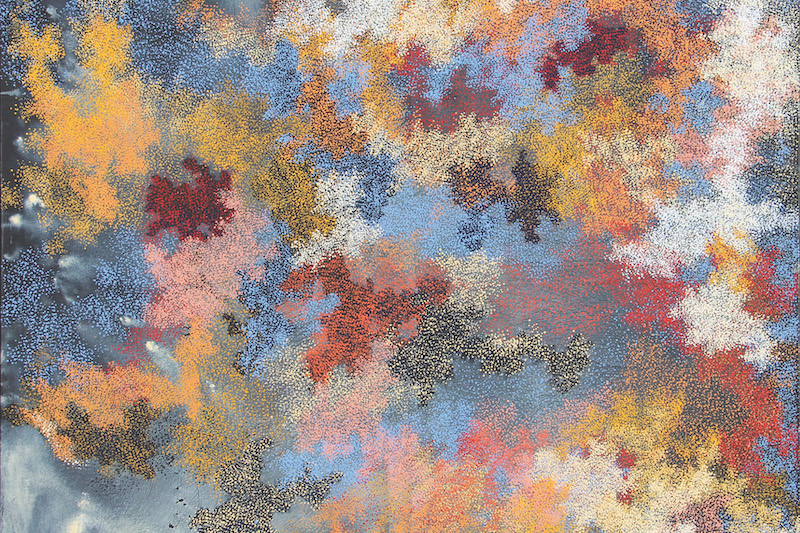Vicki Cullinan: The Sky Sees
Vicki Cullinan’s paintings depict munga ilkari, the southern night sky that symbolises an omniscient force in the remote communities of the APY Lands.
Words: Andrew Nicholls
LIKE MANY ARTISTS on community, Yankunytjatjara painter Vicki Cullinan learnt by example. “I started by watching my aunties and all the ladies in the Art Centre. When I was at school I would visit and they’d be making batik or lino-cuts. I watched them work and listened to them.” Two decades later, Cullinan is a renowned community leader and long-term member of Iwantja Arts in South Australia’s remote Anangu Pitjantjatjara Yankunytjatjara (APY) Lands. Born in Port Augusta in 1970, but soon settled in Indulkana, one of the Lands’ six major communities (which at that time comprised merely a handful of buildings), Cullinan is now one of Iwantja’s most recognised artists, regularly exhibiting across Australia.
Cullinan’s sublime paintings depict munga ilkari, the southern night sky that represents an omniscient force in remote communities. “The sky is the largest presence watching these lands” she states. “It holds all our ancestral stories from a long time ago. It watches every day what happens in our community: the chaos, the beauty, the hard times, the laughter. The sky sees and knows everything. It holds all this energy and reflects back on us at night, it is forever and it is still.”
Her canvases are built up with layers of luminous paint, swirling whorls of earth colours streaked with spattering dot work evocative of stars. “When I’m paint- ing, I try to tap into the calm energy of the night sky … my painting process is meditative, there’s no planned outcome. I’m usually working on a few at the same time, building up layers of colour and different mark-making, balancing dark and light, calm and energetic.” Cullinan has compared her sky paintings to landscapes, and indeed they could equally read as the shimmering patternation of wind-swept desert grasses, evoking the beauty of her Country both by day and by night.
In line with Iwantja’s multi-artform approach, Cullinan occasionally experiments with other mediums, including “…different printmaking techniques, drawing, and ceramics”, she says. This has recently expanded to include filmmaking via The Iwantja Women’s Film Project, which builds upon the success of Never Stop Riding, a mock Spaghetti Western created by a number of Iwantja’s male artists paying tribute to their shared backgrounds as cattle drovers. “The community was so proud of this project and it got so many young fellas involved in our Art Centre,” says Cullinan. “The senior artists got their grandsons involved and the young men really felt a sense of ownership and were so proud to see themselves up on the screen”.
Since its premiere at TARNANTHI in 2017, Never Stop Riding has shown across Australia and internationally, triggering Cullinan and her female colleagues to develop a companion work of their own. “This time we’re saying, it’s the kungka’s (ladies’) turn!” She laughs. “It’s really important for us to bring in the next generation of artists to get involved with the Art Centre – they might think that painting is just for older ladies, so we want to show them that there’s lots of different ways to be involved and share ideas and culture.”
In addition to her art practice, Cullinan has been a chairperson of Iwantja Arts for several years, is a director of the APY Art Centre Collective, and a certified transla- tor of Pitjantjatjara and Yankunytjatjara. Her donning of many different hats is driven by her love of Country and culture. “I love my Art Centre, it’s the most important place in our community – where young and old people work side-by-side, sharing culture and building a strong arts business for our children and grandchildren … We’re so proud to be part of Sydney Contemporary this year, and I can’t wait to share my new paintings with everyone!”
The Iwantja Women’s Film Project will premiere at TARNANTHI in October 2019. Cullinan is additionally working toward a solo exhibition, Munga Ilkar (the night sky) to open at Short Street Gallery, Broome, in September 2020.
This article was originally published in Sydney Contemporary Special Edition Art Collector, 2019.









